Seasons – June 2022
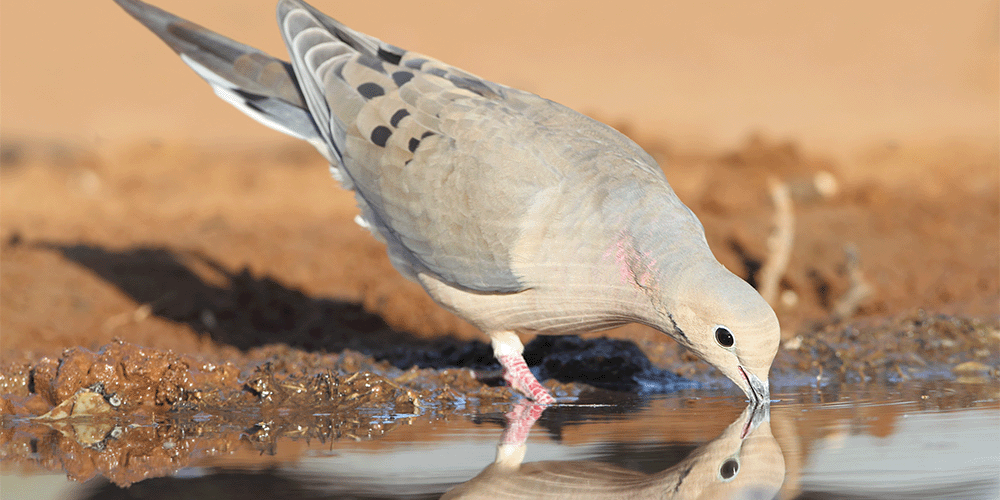
From the Plateau Land & Wildlife Management Team
The first half of the year seems to have flown by and another hot, Texas summer is upon us. As the kids start to get out of school, and more of us begin to flock to our properties for some recreational downtime, there are lots of fun activities that you can do on your property that also benefit your wildlife.
In this issue of Seasons, you’ll find articles, blogs and videos about increasing water retention on your land, implementing supplemental water, a checklist to ensure you are prepared for your summer management activities, news for Texas landowners, and more!
Be sure to stay safe and cool out there as temperatures rise, and as always, please feel to reach out if there’s anything we can do to help you protect, enhance or better enjoy your land.
Until next Seasons,
The Plateau Team

Table of Contents
Creative Ways To Increase Water Retention On Your Land
Plateau Partnership Recognized For Outstanding Land Stewardship
Summer Wildlife Management Checklist
Activity Reminder: Supplemental Water
Field Notes: Pictures & Highlights Of Properties In Wildlife Management
News for Texas Landowners
Creative Ways To Increase Water Retention On Your Land
By Beyrl Armstrong, Co-Founder of Plateau Land & Wildlife Management
Water gives life to the natural world. Without water, soils become dirt, plants perish, and animals vanish. Other than water stored in lakes and rivers, rainfall is the only source of life-giving water.
In Texas, the amount of water that falls on a particular piece of property varies greatly depending upon its geographic location. The Piney Woods of East Texas can receive 50-60 inches of rain in a year while the deserts of West Texas can barely count on 8-10 inches of annual rainfall. Annual rainfall in the rest of Texas falls between these two extremes. The amount of water that is available through rainfall on any given piece of property can be referred to as the “water budget” of that property. In order for landowners to establish what the water budget is on their property, they need to first understand where their property lies geographically in Texas. The map below, created by the Texas Water Development Board, illustrates the average yearly rainfall by county in Texas.
Once the amount of rainfall (the “income” in the water budget) is determined, then a landowner can begin to plan for the best way to manage that budget.
Considerations for Water Retention 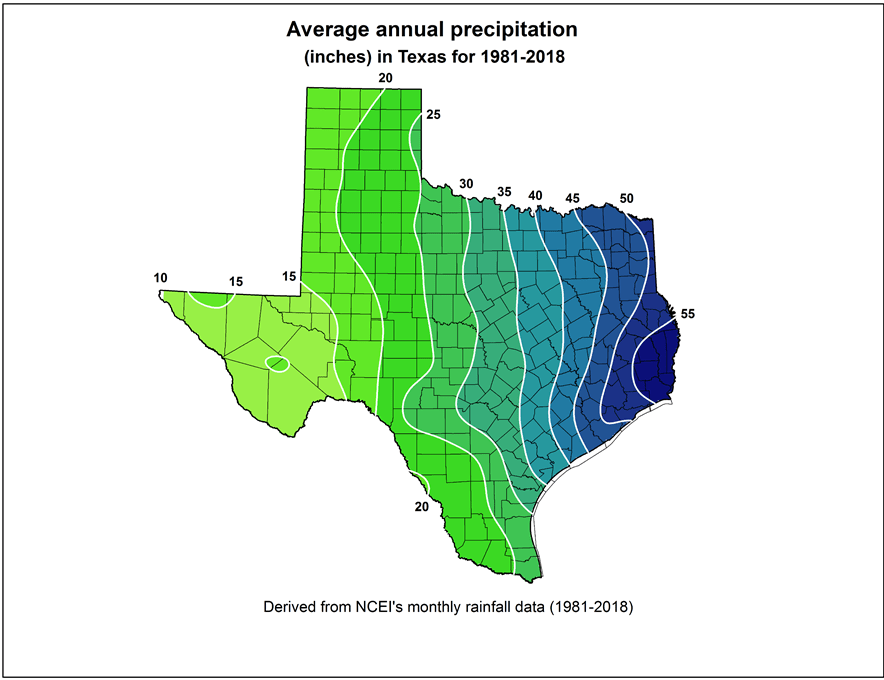
Like all budgets, the income must be balanced against expenses. Savings accounts should be developed to protect against variances in income and increases in expenses. In order to devise an effective water budget, it is important to understand the things that affect the amount of water that can be retained from the original rainfall input. These “expenses” are:
- Evaporation – the return of water to the atmosphere from the surface of leaves, bare ground, water bodies, and impervious surfaces (roofs, roads, etc.).
- Transpiration – the exhausting of moisture from plants and animals.
- Interception – plant cover that does not allow for rainfall to reach the ground and is a source of both evaporation and transpiration.
- Runoff – the flow of water across the surface of the land.
Water retention can be considered the “savings account” in the water budget. Water can be retained in ponds and lakes, wetlands and marshes, moist soils, and, ultimately, by infiltration that may eventually recharge aquifers for underground storage.
Things to consider when managing land to maximize the retention of water are:
- Local climate – humidity levels affect evaporation rates.
- Aspect – the relationship of a property to the sun, i.e., west, and south-facing slopes have a higher evaporation rate and are drier than east, and north-facing slopes.
- Slope angle – steep slopes can allow for more runoff and less infiltration.
- Impervious cover – exposed rock, hardened soils, roads, and rooftops.
- Plant Cover – density and types of plants that are located on the property.
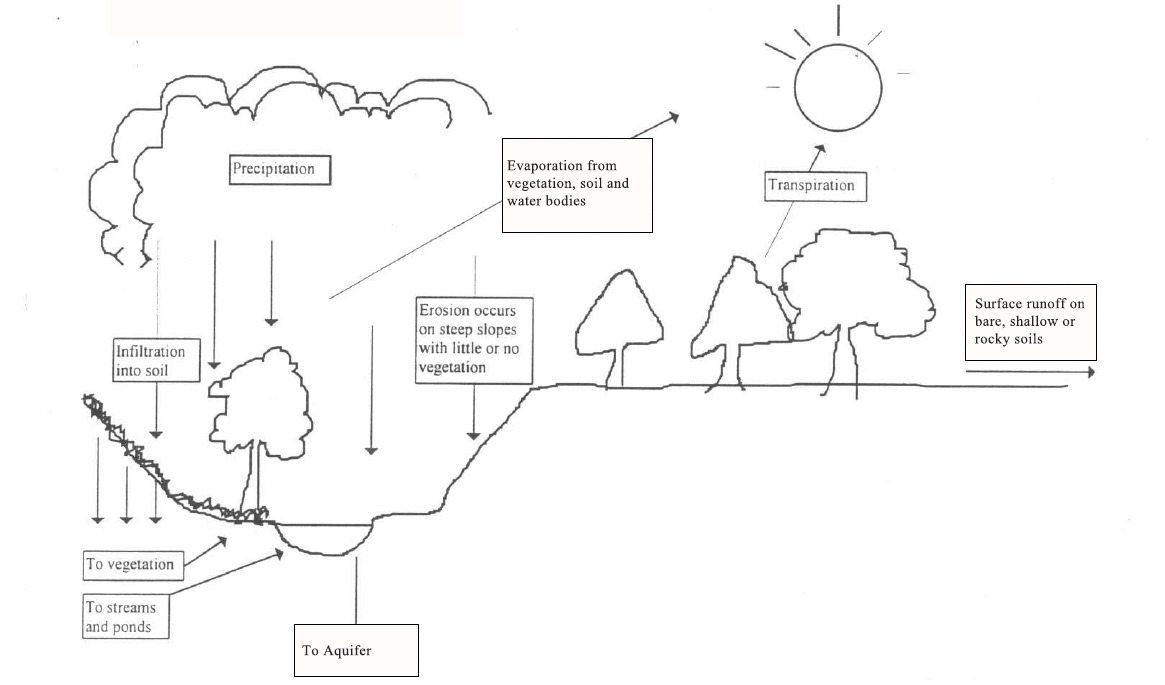
The illustration above shows how the “Water Cycle” works. Inputs from rain are balanced against evaporation, transpiration, runoff, infiltration, and recharge.
Now that the planning parameters have been established, it’s time to come up with a water budget for a sample piece of property:
Let us say that a landowner has a 60-acre piece of property located in Blanco County. The terrain is rolling hills with an intermittent creek flowing through the middle of it. Along the creek are flat, deep-soiled “benches”. Most of the hills are south facing and the hilltops have very shallow, rocky soil. According to the map above, the average rainfall for the area is 30-35 inches per year. The climate is moderately humid.
In order to maximize water retention on the property, the best approach would be to increase infiltration by slowing the flow of water across the deep soil areas along the creek and on the hilltops and decreasing runoff from the hills intercepting rainfall on the steeper slopes. The runoff of water in the intermittent creek could be decreased during high volume rain events by the establishment of trees and woody shrubs within and along the banks of the creek.
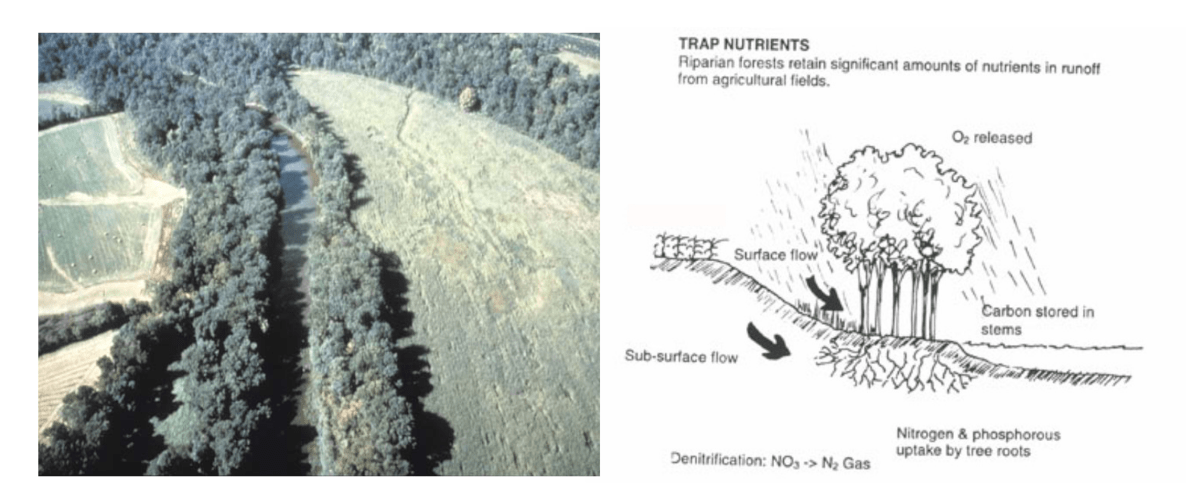
Photo and graphic provided by the Natural Resources Conservation Service. On the left shows a riparian corridor with trees along the banks to slow the surface flow of water. On the right shows how nutrients are trapped in the ground when you slow surface flow.
With these management parameters in mind, how would the landowner actively manage the property to achieve these goals?
- Reducing grazing pressure on the hilltops and creek sides would allow for tall grasses to grow, slowing the flow of water across the land, thereby improving infiltration.
- Planting a diverse blend of native grasses and perennial forbs (wildflowers) could help speed up infiltration.
- Allowing trees and shrubby plants to grow on the steep slopes would increase interception of heavy rainfall and allow it to slowly move through the leafy vegetation and be absorbed in the ground beneath the woodlands. Some water, captured by the bark and leaves of the trees would be infiltrated into the soils through stem flow within the trunks of the trees. Evaporation rates would be reduced by the increased shade provided by the woodlands on the slopes and the tall grasses covering the shallow soils on the hilltops.
- The planting and natural recruitment of trees and woody plants along and within the banks of the creek would both provide shade to reduce evaporation of any standing water in the creek and, with the presence of roots and trunks, slow water flow during heavy rains and facilitate the development of gravel beds that would act as small dams, creating more permanent pools of water within the creek bed.
Once these practices are established, periodic management of the grasslands by short-term grazing, mowing, and/or the application of prescribed fire will be needed to maintain them. The wooded areas will be self-tending.
These management practices not only help increase the infiltration and retention of water, but they also provide habitat for wildlife and are aesthetically pleasing. It takes patience for landowners to manage their land to slowly become a natural sponge. Planting native grasses can be expensive and natural recruitment of woody plants takes time. However, the benefits to the water budget, wildlife, and the pride of ownership make these management practices very much worthwhile.
Have questions about improving the water retention on your land? Please contact us at [email protected] or (512) 894-3479.
Plateau Partnership Recognized for Outstanding Land Stewardship
By Shane Kiefer, Director Of Ecological Services, Certified Wildlife Biologist, Senior Property Tax Consultant
Wuest Ranch and Natural Bridge Caverns awarded Texas Land Steward Award
The Texas Parks and Wildlife Department (TPWD) has announced longtime Plateau client and partner, the Wuest family, as a 2022 Lone Star Land Steward Ecoregion Award winner for the management of their property, Natural Bridge Caverns and Wuest Ranch. The TPWD Lone Star Land Steward Awards recognize private landowners in Texas for their exemplary contributions to land, water and wildlife stewardship.
Plateau first began working with the Wuests in 2006 when they were looking for advice on incorporating more deliberate wildlife habitat management on their ranch, which was primarily focused on livestock production at the time. They had a long history of caring for the cave and the land surrounding it, but had recently accelerated their stewardship efforts by working with the Natural Resource Conservation Service (NRCS) to manage brush, reseed native grasses, and improve their grazing management program. We recommended a number of wildlife and habitat management practices which the Wuest family incorporated into their ranch management program over the next several years.
The Wuests did all the work, taking guidance from Plateau and other experts to build a program that suited their land. Native grasses grew, deer got bigger, Wild Turkey and Bobwhite Quail could be heard calling, and the types of wildlife seen on the ranch was noticeably more diverse. By 2018, the family had added land to the ranch and desired a shift in the primary use to wildlife management, with livestock grazing as a secondary use, both as a land management tool, but also to maintain the long legacy of production on the property.
We saw the impressive changes to the ranch since 2006 and the family’s commitment to continuing to improve their ranch and to protecting the larger landscape around them, which includes Bracken Cave and a lot of high-quality endangered species habitat. Their land stewardship and a family business (Natural Bridge Caverns) dedicated to educating people about cave systems, aquifers, and the connection of the land to our water made them the perfect candidate for the Lone Star Land Steward Award.
Summer Wildlife Management Checklist
By Kameron Bain, Landowner Account Manager
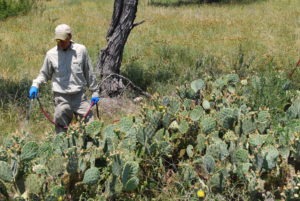
Plateau Land & Wildlife Technicians conducting chemical brush control by treating prickly pear cactus.
Prepare for summer heat and plan ahead to stay on top of your Wildlife Management
Ella Fitzgerald sang that it’s “summertime and livin’ is easy” and it definitely seems that way sometimes. No school, long days, beach vacations – all of these things can make it difficult to focus on your wildlife management plan and activities.
While you are having some fun in the sun, we encourage you to take advantage of those long summer days to meet one (or maybe even two) of your wildlife management activities. There are plenty of options to choose from this time of year, including:
- – Chemical brush control
- – Enroll in Managed Lands Deer Program (MLDP) harvest option: May 1 – September 1
- – Protein feeding for deer
– Deer surveys: Start in August - – Feral pig control
- – Pond construction or repair
- – Imported red fire ant control
- – Strip mowing: Late July and August
- – Half-cutting mesquite
- – Supplemental water maintenance
- – Camera surveys at water sources
There are plenty of timely activities to choose from, and of course, Plateau is always here to help when you need us.
To schedule a service for your property, contact us at [email protected] or (512) 894-3479.
Activity Reminder: Supplemental Water
By Kameron Bain, Landowner Account Manager
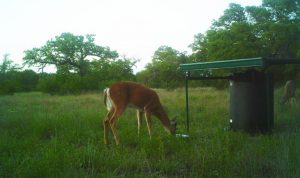
A whitetail doe enjoys a drink from a Plateau Land & Wildlife 100 Gallon Water Table.
Water is good for every target species, from pollinators like butterflies and bees to larger animals like Wild Turkey and deer. Wildlife can acquire water through three sources: free water, food, and metabolic water. Free water is any water wildlife may drink – from dew to puddles, to a flowing creek. Food provides water in varying amounts, e.g. a fresh grasshopper or fruit provides more water than dried seeds or twigs. Metabolic water is water created inside the body as a by-product of cellular respiration, and many species rely heavily on this source, particularly in arid environments.
The wildlife water source landowners can have the most direct, year-round impact on is free water. Good land management helps reduce runoff and puts water into our aquifers, where it may come up as springs to feed our creeks and rivers. Healthy wetlands and riparian habitats alongside streams help store water for more reliable flows.
Both spring enhancement and wetland creation qualify under Supplemental Water. Note that while these are natural water sources, there is an activity in the enhancement or creation. In contrast, having an existing stock tank or pond that is filled by runoff requires no activity on your part, so it does not qualify under Supplemental Water. Constructing a new pond or repairing or enhancing an existing one can qualify under other categories.
For areas on your property that have no natural water, providing artificial water sources through an existing well or livestock trough makes for an easy activity. Setting troughs at ground-level or building a ramp from rocks, wood, or hog panel makes any source wildlife-friendly. Be sure to run it from the inside-bottom, over the edge, and down to the ground outside to grant access to small wildlife and keep them safe from drowning. If you need a new trough, keep in mind that small troughs or pans lose less water to evaporation and cost less than larger livestock troughs.
That’s why we use metal dog pans on our water tables, which is another option for providing water in dry places. No well, no problem. Catch rain on a roof and store it in a cistern or water tank connected to a small pan or trough. This can be particularly good for improving water distribution on your property. Ideally, you should provide a source of free water every quarter to a half-mile across your property, though bigger properties managing for large animals such as deer or Wild Turkey can spread them out farther.
Take new pictures each year of your water sources or water-related activities for your records and annual report.
What qualifies?
- Rainwater collection systems like Plateau’s Water Tables and Quail & Small Wildlife Feeding and Drinking Station
- Modified livestock troughs with wildlife-friendly ramps offering safe access for target species – these may be filled automatically or manually as long as the water is reliable
- Well or windmill flow into artificial or earthen holding tanks at ground-level
- Natural spring enhancement/development
What does not qualify?
- Man-made lakes and ponds supplied only by overland flow or natural springs
- Rivers, creeks, streams, etc. that are natural sources (not a supplement but they are great for wildlife)
For questions about your supplemental water activity, or if interested in purchasing a Plateau Water Table or Wildlife Station contact us at [email protected] or (512) 894-3479
Field Notes: Pictures & Highlights Of Properties In Wildlife Management
Ever wonder how Wildlife Management is benefiting landowners’ property and the wildlife that lives on it? Here are some photos and highlights of successes and small victories our landowner customers are seeing on their property.
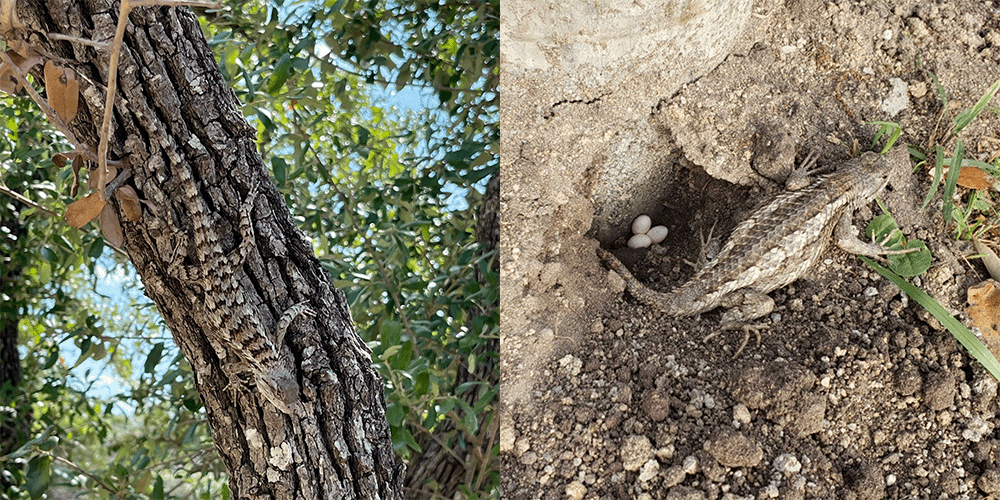
Texas Spiny Lizard (at left) on an oak tree, and female Texas Spiny Lizard (at right) with a clutch of eggs.
Lizards in Blanco County and Fayette County
Check out these Texas Spiny Lizards, also known as Sceloporus olivaceus, caught on a camera by two Plateau clients!
This Texas Spiny Lizard (left) was spotted on an oak tree in Blanco County. The Texas spiny lizard habitat consists of areas with dropped leaves, oak and mesquite trees. Common throughout Texas, this reptile is often found climbing trees and fences and scrub vegetation in suburban areas. They are very fast climbers and have specialized toe claws that enable them to easily climb tree bark. They are arboreal, which means they spends most of their time in trees. Texas Spiny Lizard feed primarily on grasshoppers, blister beetles, June beetles, pill bugs, spiders and mites. These lizards are also diurnal, meaning they’re most active during the daytime. Male and female spiny lizards look alike, with a few differences in colors, however, males have small blue patches near their ribcage that females don’t have. With the bold back pattern on this lizard, it is likely a female, but we can’t be certain without examining for colored patches on its sides.
This female Texas Spiny Lizard (right) was spotted by a landowner in Fayette county with a recently laid clutch of eggs. Texas Spiny Lizards usually begin mating in mid-March through early summer. When the female Texas Spiny Lizard is ready to lay her eggs, she descends from the trees to the ground in search of an area of loose soil that will make a good nest site. She will select the appropriate site in the soil and dig the nest herself, and will then lay as many as 20 eggs in a shallow cavity. Mature Female Texas Spiny Lizards can lay anywhere from 1 to 4 clutches of eggs from April through August.
So many of you are out there doing great work. We appreciate you, and so do the native wildlife on your property and across Texas. Large or small, you are making a difference. Look for more great examples of wildlife and landowner successes and victories in upcoming Seasons Newsletters!
News for Texas Landowners
Texas voters approve two modest property tax relief measures
Article by JOSHUA FECHTER for The Texas Tribune
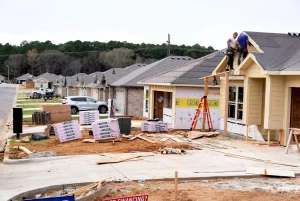
As the state’s housing market rages, Texas homeowners will get a slight break on their property tax bills after Texas voters overwhelmingly passed a pair of statewide ballot measures Saturday.
Voters approved two propositions intended to lower property taxes for homeowners by decisive margins — one aimed at older and disabled Texans and another that would provide modest relief for homeowners across the board.
Texas’ high property taxes have once again taken center stage amid the state’s real estate market explosion. Home values in the state’s major metropolitan areas have surged by double digits, prompting homeowners to fret that they will see a similar rise in their property tax bills — though those don’t necessarily go hand in hand.
By Victoria G. Myers , Progressive Farmer
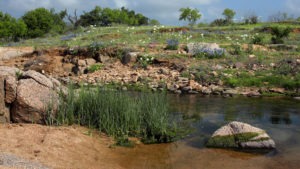
Justice Jane Bland delivered the opinion of the Texas Supreme Court on the Hlavinka case, which first made its way through the trial court and then through the Court of Appeals for the First District of Texas. There were several issues put before the court, but the one that has landowners encouraged today was how the court viewed valuation of a condemned property easement. Here the difference was huge between what the landowners said the easement was worth (about $3.3 million) and what the pipeline company wanted to set the price at (just over $23,000).
In remanding the case back to the trial court, Justice Bland wrote: “A condemnation should not be a windfall for a landowner. Nor should it be a windfall for a private condemnor. A condemnor must pay a fair price for the value of the land taken.”
By Arthur Clayborn and Christian Terry for KLTV East Texas
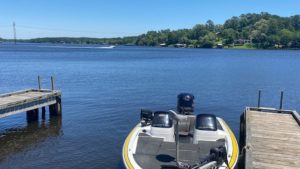
Giant Salvinia, often called aquatic hitchhikers because its spread by boaters from lake to lake, can make fishing, boating, swimming nearly impossible. Biologists say you can help stop the spread by remembering to clean, drain and dry boats and equipment
“You can get these masses that are anywhere from two inches to three feet thick and you’re not getting that sunlight penetration down into the water so the aquatic vegetation that was once providing oxygen to the lake for the fish and other aquatic life to use is now been choked out,” said John Findeisen, Texas Parks and Wildlife Biologist.
A sea turtle neared extinction. A trove of eggs shows it can be saved.
Marisa Iati for The Washington Post
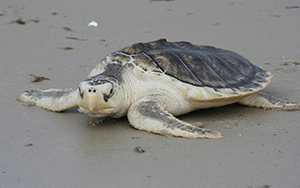
“Because Kemp’s ridley sea turtles are the most critically endangered sea turtles in the world, every egg matters,” said Christopher Marshall, director of the Gulf Center for Sea Turtle Research at Texas A&M University at Galveston, which runs the conservation program.
Feral Hogs No Longer Just A Rural Problem
Kyle Mooty For Lockhart Post Register
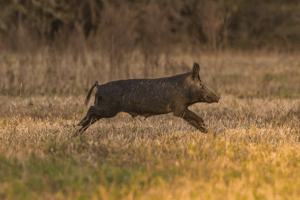
It’s a problem that is not getting any better, and despite the State of Texas declaring a bounty on their lives, feral hogs continue to thrive while simultaneously wreaking havoc on the local environment.
It’s a simple math problem. Since 2013, more than 17,000 hogs have been removed from the Plum Creek Watershed, yet one sow on average (litter sizes, females, etc.) can be responsible for 128,000 pigs over a five-year stretch. By any formula, Texas is losing ground to the pigs.
It was once a problem in the rural areas, including farmland, but the ever-growing population has now found its way into cities, including rooting up yards in subdivisions and causing countless problems for homeowners and developers.
Will Elon Musk Deliver on His Promise of an “Ecological Paradise” at the Tesla Factory in Austin?
By Will Bostwick for Texas Monthly
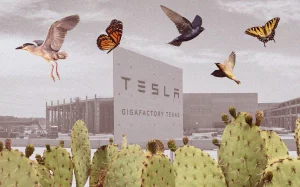
An osprey flaps its way upstream, a freshly caught fish in its talons, as we paddle down a calm stretch of the Lower Colorado River on a bright April evening. The sound of rippling water blends with the steady hum of traffic. Motorists speeding over the river on Texas Highway 130, just east of us, may not even notice the Colorado. We’re surrounded by a fast-growing patch of urban sprawl near the Austin airport, about eight miles east of downtown. New housing developments, shops, and office parks are popping up at a rapid clip, but you wouldn’t know it from the perspective of a canoe. This shallow portion of the river is brimming with waterfowl and countless other riparian creatures. Nearby, a fisherman casts from shore, while kids splash in the olive-tinted water. With the river reflecting the early evening sun, we round a slight bend. There, in the distance, set back along the Colorado’s banks, rises Tesla’s Gigafactory Texas, its 4.3 million square feet covering an area the size of 75 football fields, all enclosed in austere concrete walls.
Report: There is believed to be $340M worth of treasure buried across Texas
Article by KVUE Austin
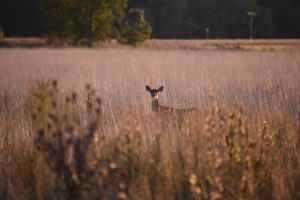
The search for treasure in Texas could make you a multimillionaire. According to TexasHillCountry.com, Texas is thought to have around $340 million in buried treasure — more than any other state in the U.S. Many of the state’s estimated 229 treasure sites are reportedly hidden under layers of limestone and spread across the Texas Hill Country.
So, what are we waiting for? Well, first you need permission from landowners before you start digging. But once you have permission, here are some of the possible hiding spots in Central Texas. Legendary outlaw Sam Bass is rumored to have buried his treasure from stagecoach, bank and train robberies in parts of the Hill Country. Multiple sources say Bass hid the treasure in a hollow tree two miles west of Round Rock, but it has yet to be found.
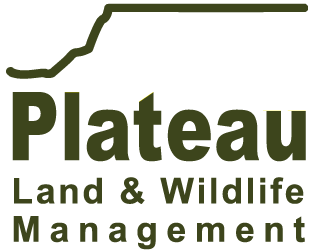




Sorry, the comment form is closed at this time.